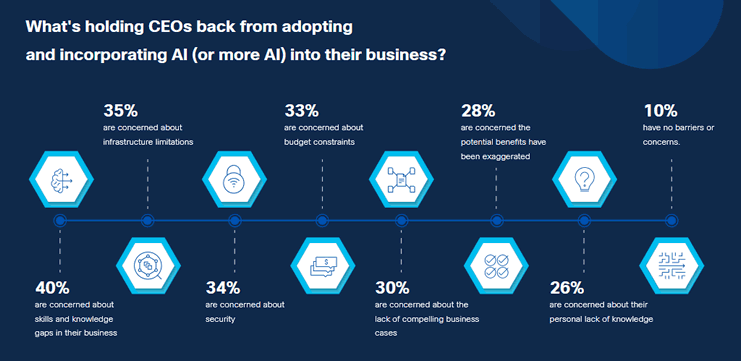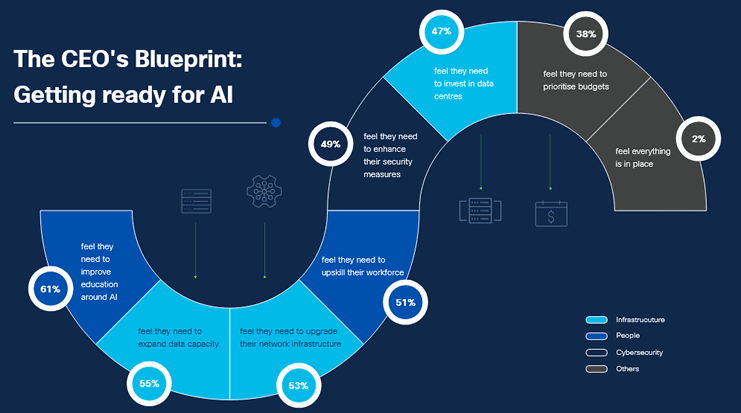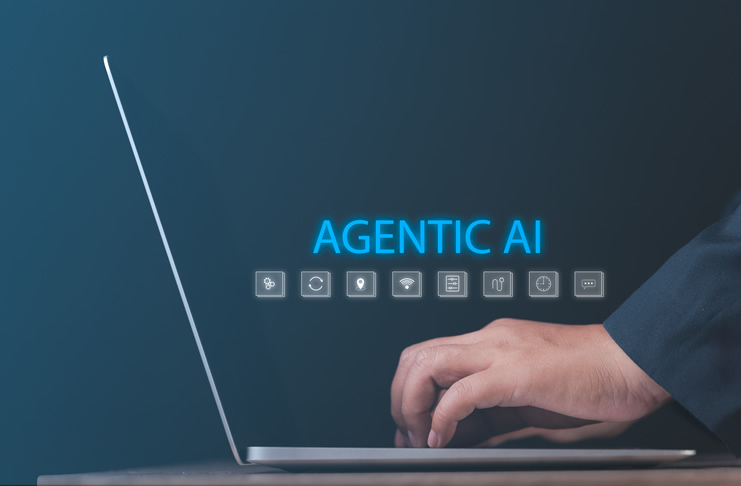Most CEOs see the benefits of incorporating AI into their organization’s activities, but knowledge/skills gaps and several other factors hinder decisions and AI adoption – can they be overcome?
AI literacy is one of the main concerns mentioned in an overview of Gartner’s top AI trends 2025. It includes many knowledge aspects tailored to who one wants to learn the use of AI and its advantages, disadvantages, and strategies to leverage AI successfully.
Implementing and using AI naturally also requires IT knowledge and the necessary skills and knowledge at the executive level. As often happens with technologies that are still too recent for many companies to be widely adopted, knowledge gaps are an obstacle to their adoption. It is no different for artificial intelligence.

Barriers to AI adoption: from knowledge gaps and budget constraints to doubts and concerns
According to a survey commissioned by Cisco, 97 percent of CEOs plan AI integration, but only 1.7 percent feel fully prepared to do so. Of course, the latter is not just about knowledge. However, skills and knowledge gaps rank at the top of the barriers to AI adoption. To be precise, 40 percent of those surveyed fear losing ground on AI due to gaps in IT knowledge.
In second place, with 35 percent of responses, we find infrastructure limitations, followed immediately by concerns about security (34 percent) and budget constraints (33 percent).
Interestingly, thirty percent of those surveyed also do not immediately see convincing business cases, and 28 percent find the benefits (of AI) exaggerated.
It’s unclear if the CEO study conducted by Opinion Matters for Cisco asked the 2,503 CEOs about specific forms of AI or asked them about AI in general (it is a broad domain, of course). Cisco, however, does promise a companion study in the coming months. Still, the list of barriers to AI adoption shows something we have seen with almost every new technology trend companies should adopt.
We all know the phenomenon of Hype Cycles. We also know that often, at first, there’s much talk about the technologies as such (whereby one can be an early adopter or wait and see per many pundits) when there aren’t real clear cases yet but only pilots and attempts to discover the pros, cons, and possibilities in test environments.
97% plan to adopt and incorporate AI (or more AI) into their business But only 2% feel ready for AI. 74% believe their understanding of AI poses a barrier to their ability to ask critical questions in the boardroom.
The fact that a good percentage of companies do not see immediately compelling use and business cases, as the study also shows, may have several causes, one of which is a solid knowledge of the possibilities. However, the fact that 28 percent of respondents find the benefits exaggerated is not to be underestimated – and requires a good understanding of how this will evolve as new trends emerge and improve existing AI methods.
Add to the just mentioned findings the fact that 26 percent of CEOs fear they don’t have enough knowledge (about AI), and, along with the skills and knowledge gaps, they pose a challenge that we see with every new technology. Just think of earlier technologies for digital transformation, such as the Internet of Things, to name just one.

Of course, this does not mean that in a few years, we will hear much less about AI than we do now, although other technologies already appear on the list of future hypes. This includes several technologies and trends that fall under the enormously broad term AI. Think of the hype around agentic AI and other AI trends and innovations that are coming and will continue to come.
However, if many companies do not see the benefits, do not have the knowledge at various levels, and have concerns (such as cybersecurity), then there is much work to do. The market is really evolving too fast for organizations, and geopolitical discussions regarding AI, as we see now with apparent differences between, for example, the U.S. and the EU, create a lot of confusion and uncertainty for AI adoption.
For Cisco, it is good news that organizations need additional infrastructure. Still, the same challenges play here: the companies with budget constraints or other reasons to hold off the boat will not want to do anything about it immediately. One thing is sure: Solving the challenges regarding skills, knowledge gaps, and infrastructure limitations costs time and money. In the current geopolitical context, the latter becomes a serious challenge, even if one of the promises of AI is, of course, saving time and costs – after having invested, that is.
“Whole businesses will be revolutionized if they can unlock AI’s potential to innovate faster, simplify their operations, and withstand digital disruptions. But no one can do it alone. That’s why 96% of CEOs are leaning on trusted partners to make the leap.” (Oliver Tuszik, President of Cisco EMEA)
CEO transformation blueprint for AI adoption and an AI-driven future
Most CEOs, about 4 in 5, see AI’s potential. Still, they worry that gaps in their understanding and knowledge will affect strategic decisions, putting them at risk of missing opportunities and falling behind competitors. We have also seen such findings with just about every new significant technological change in recent decades.
CEOs want AI because 97 percent say they want to adopt and incorporate AI (or more AI). Of course, we should not forget that AI – in the broad sense – has already been used in many companies in various areas: in combination with the previously mentioned Internet of Things, for example, or in information management, intelligent document recognition (IDR), myriad Industry 4.0 applications, sales and marketing tools, smart building management systems, and so much more. And then there’s GenAI, with tools such as ChatGPT being used for both personal and professional purposes, often without leadership knowing to what extent this happens across the organization.

For Cisco, the conclusion of the study is clear. People, infrastructure, and cybersecurity are the CEO transformation blueprint for an AI-driven future, but fear or lack of investment could hold CEOs back.
Whether CEOs will hold AI adoption back effectively depends on many factors; quite a few are out of companies’ control.
To get ready for AI, improving AI education ranks first on the CEO blueprint with 61 percent. And that includes AI literacy indeed. Next, per the survey, come expanding data capacity, upgrading the network, upskilling the workforce, enhancing security, investing in data centers, and prioritizing budgets. And the key to it all, per Cisco: partnerships and bold technology leadership.
You can find the exact ways companies want to address all the challenges and more data and conclusions from the survey in Cisco’s press release and in a summary PDF of the study, entitled ‘Cisco’s 2025 AI Briefing: CEO Edition – essential insight on CEO fears, ambitions, and action on AI‘.






